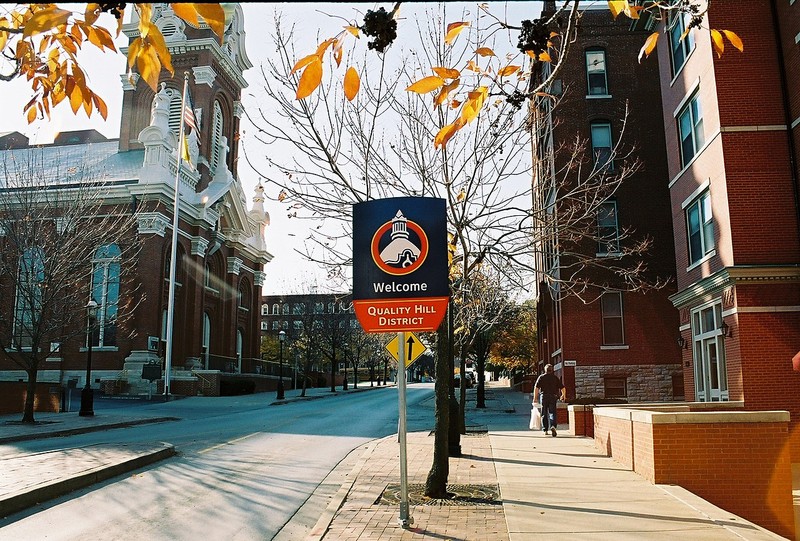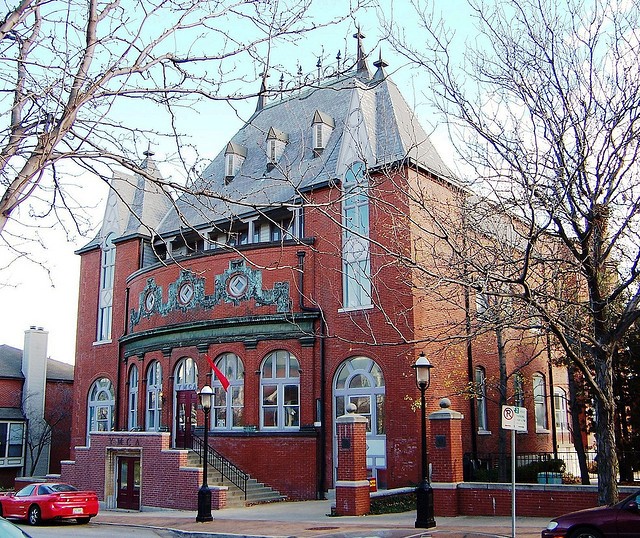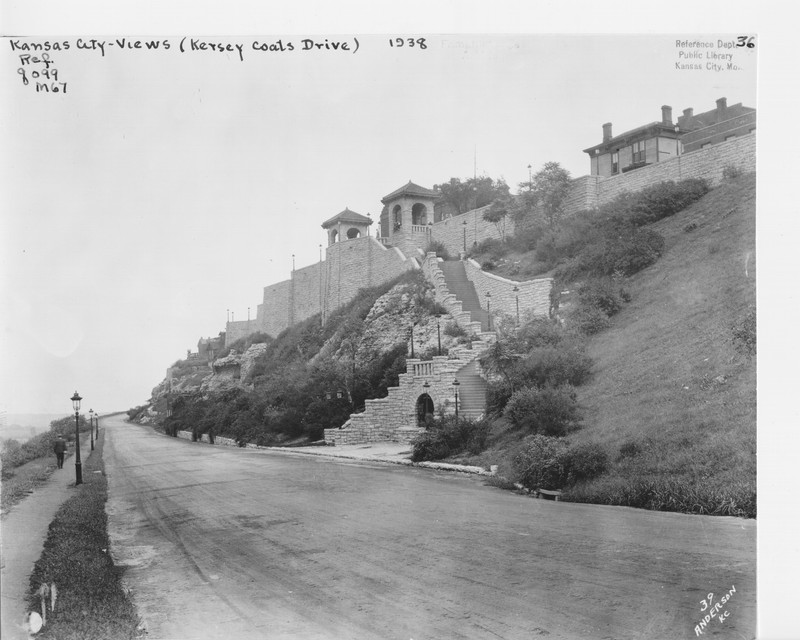Quality Hill Overlook and Historic District
Introduction
Text-to-speech Audio
The Quality Hill neighborhood is the oldest, continuously inhabited residential area in Kansas City. West Terrace Park is located on what is now the far west edge of the neighborhood and offers a stunning overlook from the bluff which includes the Kansas and Missouri River valleys. The neighborhood was first platted as an upscale neighborhood around 1857 by prominent businessman Kersey Coates (1823-1887). The name of the neighborhood reflects its one-time reputation as the most prestigious neighborhood in the city, a reputation that continued until the decades after World War I. West Terrace Park was created in the early 1900s and included the stone towers at both sides of the overlook.
Many leading figures, including wealthy transplants from the east coast, resided here in homes designed in a variety of styles. The neighborhood also includes religious, commercial, educational, and apartment buildings. Two of its prominent landmarks are the Cathedral of the Immaculate Conception (the seat of the Diocese of Kansas City-St. Joseph) and the Progress Club building, which is now a YMCA. Quality Hill saw outmigration and was later the site of housing projects, many of which have been replaced in recent years as the neighborhood experiences another transition that has followed the return of residents and businesses to the downtown area. This park was reduced in size in the 1960s as part of the effort to construct I-35, but the historic overlook remains. The neighborhood was added to the National Register in 1978 and a smaller part of the neighborhood was added to the National Register as the Quality Hill Center Historic District in 2017.
Images
Quality Hill is the oldest, continuously inhabited neighborhood in Kansas City. The Cathedral of the Immaculate Conception, located on the left, is one of the prominent landmarks in Quality Hill.

The Progress Building

West Terrace Park as it looked in 1938

Backstory and Context
Text-to-speech Audio
The origins of Quality Hill coincide with the early history of Kansas City. In 1821, fur trader and businessman François Chouteau established a fur trading post called Chouteau's Landing on the southern side of the Missouri River in what is know Riverfront West (Chouteau belonged to prominent French family in the region. His father received trading rights with the Kansa Indians in 1790). After a flood in 1826, he moved the post to the north end of Troost Avenue in 1826. Chouteau's business prospered and his trade network extended throughout the Kansas territory.
In 1835, a French priest named Fr. Benedict Roux built the first permanent church—a log cabin—called St. John Francis Regis in Quality Hill at 11th and Pennsylvania. Chouteau and many members of his family and employees attended the church. As a result, it became known as "Chouteau's Church." A rectory and a small cemetery were also on the property. In 1857, another priest by the name of Fr. Bernard Donnelly, who earned the nickname "the builder," built a new, much larger brick church named Immaculate Conception. The present church was built just to the west in 1883.
Kersey Coates, who was born to a Quaker family in Pennsylvania, visited Kansas City in 1854, a year after the city was officially established. Seeing a potential opportunity to develop the bluff overlooking the valleys, Coates bought a large part of the area around 1857 to create an upscale residential neighborhood. The construction of the first Immaculate Conception church played an important in helping attract others to the area. The former mayor of Kansas City, Dr. Johnston Lykins, built a mansion in 1857 and Coates built a home of his own in 1859. After the Civil War, many former Union officers and their families settled in Quality Hill (Coates served in the war as well, rising to the rank of colonel in the Missouri militia). The name Quality Hill originated with southern and Confederate sympathizers who derided the wealthy residents of the neighborhood and also called them "silk stockings," which was another nickname for Republicans. Over time, the term "Quality Hill" was simply recognized as the name of the neighborhood.
In the 1880s, Quality Hill experienced a building boom. More than half of the buildings in the neighborhood were erected during the decade. Other religious congregations built churches as well including the Swedish Evangelical Lutheran Church and Grace and Holy Trinity Cathedral. A number of hotels were also built. The Progress Club was built in 1893 as a social club for prominent Jewish families.
Beginning in the early 1900s, many original residents left Quality Hill due to three main reasons. One was the smell of the meat packing houses located below the bluff. Another was the high cost of modernizing the Victorian-era homes built in the neighborhood. The third reason was that there was little land available for new construction. As a result, wealthy residents moved southward into new subdivisions. The homes in Quality Hill were then subdivided into apartments, flats, and rooming houses for working-class residents who were moving to the city in increasing numbers at the time. Several family hotels/apartment buildings were erected in between 1900 and 1920 as well. Over time, however, the area began to decline and by the 1940s it became a blighted neighborhood.
In the 1950s, six apartment buildings intended for working-class residents were built on land cleared of old buildings. Known as Quality Hill Towers, they were meant to help revitalize the area (two have been demolished). The apartment building known as 910 Penn was erected behind the towers in 1958. These buildings were the first projects in Kansas City under the state's recently passed redevelopment legislation and the city's urban redevelopment ordinance. Quality Hill continued to be revitalized and by the late 20th century it had evolved into a vibrant neighborhood with mixed-income housing and retail.
Sources
Backer, Linda & Miszczuk, Edward J. "Quality Hill." National Park Service - National Register of Historic Places Nomination Form. July 7, 1978. https://mostateparks.com/sites/mostateparks/files/Quality%20Hill.pdf.
"Chouteau’s Church (St. Francis Regis)." The Historical Marker Database. Accessed September 20, 2022. https://www.hmdb.org/m.asp?m=86217.
"Cathedral History." Cathedral of the Immaculate Conception. Accessed September 20, 2022. https://kcgolddome.org/about-us.
Coombs, CJ. "Quality Hill is a historic area and is said to be one of the first neighborhoods in Kansas City." Newsbreak. August 16, 2022. https://original.newsbreak.com/@cj-coombs-1589302/2707889337503-quality-hill-is-a-historic-area-and-is-said-to-be-one-of-the-first-neighborhoods-in-kansas-city.
Dietrich, Donald A. Master's Thesis: "Urban Planning and Historic Preservation, Quality Hill, Kansas City, Missouri." Kansas State University. 1960. https://krex.k-state.edu/dspace/bitstream/handle/2097/23814/LD2668R4PLAN1987D53.pdf?sequence=1.
Euston, Diane. "Fr. Bernard Donnelly: "The Builder" of Kansas City." The Santa Fe Trailer. April 29, 2019. https://newsantafetrailer.blogspot.com/2019/04/fr-bernard-donnelly-builder-of-kansas.html.
"Kansas City’s First Communities: Quality Hill…Kansas City’s Silk Stocking Ridge." Historic Kansas City. Accessed September 20, 2022. https://www.historickansascity.org/event/kansas-citys-first-communities-quality-hill-kansas-citys-silk-stocking-ridge.
Magerl, Barbara. "Berenice and Francois Chouteau - Founding Residents of Kansas CityBerenice (1808-1888); Francois (1797-1838)." Missouri Valley Special Collections. 2003. Retrieved from the Kansas City Public Library on September 20, 2022. https://kchistory.org/islandora/object/kchistory%253A115526.
Nugent, Rachel. "Quality Hill Center Historic District." National Park Service - National Register of Historic Places Nomination Form. April 3, 2017. https://mostateparks.com/sites/mostateparks/files/Quality%20Hill%20Center%20HD.pdf.
"Quality Hill." Rudy Bruner Award. Accessed September 20, 2022. https://www.rudybruneraward.org/winners/quality-hill-2.
Anderson Photo Company. West Terrace Park, Kansas City Public Library General Collection (P1), Parks--West Terrace, Number 4. Accessed September 20th, 2022. https://kchistory.org/image/west-terrace-park-0.
Both images via Wikimedia Commons: https://commons.wikimedia.org/wiki/Category:Quality_Hill
https://kchistory.org/image/west-terrace-park-0
